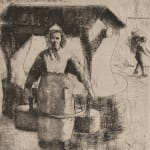Camille Pissarro (1831-1903)
Peasant Woman at the Well (Paysanne au Puits), 1891
Etching and aquatint on laid paper
235 x 194 mm. (9 1/4 x 7 5/8 inches)
Signed, titled & numbered '3 etat no 2'
Delteil 101 third (final) state
The composition of Paysanne au Puits was essentially complete in the first state of the print (known in one impression); in the second Pissarro scratched the plate (seemingly burnishing areas...
The composition of Paysanne au Puits was essentially complete in the first state of the print (known in one impression); in the second Pissarro scratched the plate (seemingly burnishing areas of aquatint) to clarify and lighten areas of the woman’s dress and face, and further lightening was done for the third state. In this impression Pissarro left substantial overall plate-tone which tends to mitigate in part the lightening effects of the work done in the third state; the mood created is thus relatively dark, and the print’s profound aesthetic effects are achieved through the etching and plate work rather than selective plate wiping.
Pissarro personally printed only 9 impressions of Paysanne au Puits, and these are the only lifetime impressions. There was one of the first state, 3 of the second, and 5 of the third. This impression is numbered 2 (of the 3 state). The impression numbered 4 is in the Musee du Luxembourg; the impression numbered 1 is at the Ashmolean at Oxford.
Pissarro was perhaps the most active printmaker of the Impressionists; printmaking was an essential component of his career, and he was deeply involved in the process of creating and printing his prints. By mid-career Pissarro had made many etchings, using fairly conventional techniques (although of course aesthetically his work was hardly conventional), but it was Degas who introduced Pissarro to a range of unusual ways of working with the etching plate – especially the use of aquatint. At this point Pissarro was about 50. He worked closely with Degas for several years; they both enjoyed making prints in many successive states, working to refine an image or composition, and often incorporating accidents or unanticipated results in the print.
By the early 1890’s Pissarro was having some eye problems which prevented his working out of doors. He re-focused on printmaking, eventually (in 1891, the year Paysanne au Puits was made) buying a press so he could print them himself conveniently. Pissarro apparently saw printmaking as a way of evolving an image, experimenting with variations on a theme. He was not concerned with making exactly repeatable impressions, or making a lot of impressions; for him the printing process itself was part of the artistic endeavor.
Today the vast majority of Pissarro prints on the market are posthumous impressions (there were 50 posthumous impressions of Paysanne au Puits), and it is unfortunate that many know his work only through these inferior impressions; it is only through his lifetime impressions that one can appreciate Pissarro as one of the great masters of printmaking.
Pissarro personally printed only 9 impressions of Paysanne au Puits, and these are the only lifetime impressions. There was one of the first state, 3 of the second, and 5 of the third. This impression is numbered 2 (of the 3 state). The impression numbered 4 is in the Musee du Luxembourg; the impression numbered 1 is at the Ashmolean at Oxford.
Pissarro was perhaps the most active printmaker of the Impressionists; printmaking was an essential component of his career, and he was deeply involved in the process of creating and printing his prints. By mid-career Pissarro had made many etchings, using fairly conventional techniques (although of course aesthetically his work was hardly conventional), but it was Degas who introduced Pissarro to a range of unusual ways of working with the etching plate – especially the use of aquatint. At this point Pissarro was about 50. He worked closely with Degas for several years; they both enjoyed making prints in many successive states, working to refine an image or composition, and often incorporating accidents or unanticipated results in the print.
By the early 1890’s Pissarro was having some eye problems which prevented his working out of doors. He re-focused on printmaking, eventually (in 1891, the year Paysanne au Puits was made) buying a press so he could print them himself conveniently. Pissarro apparently saw printmaking as a way of evolving an image, experimenting with variations on a theme. He was not concerned with making exactly repeatable impressions, or making a lot of impressions; for him the printing process itself was part of the artistic endeavor.
Today the vast majority of Pissarro prints on the market are posthumous impressions (there were 50 posthumous impressions of Paysanne au Puits), and it is unfortunate that many know his work only through these inferior impressions; it is only through his lifetime impressions that one can appreciate Pissarro as one of the great masters of printmaking.



